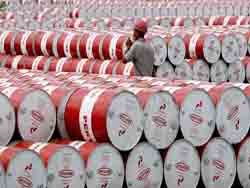
If half a billion barrels, which reported the International energy Agency, has never existed, we can expect a sharp increase in oil prices
What would happen with the oil market, if all commercial stocks of oil in the U.S., amounting to approximately 500 million barrels, suddenly disappeared? This is not an idle question. Statistics world oil balance, according to the international energy Agency (IEA), suggests that oil production in the last half year exceeded demand (including stocks and oil in transit) just at 500 million barrels. These barrels were supposedly made, but does not record statistics on the demand side. The problem has been widely discussed last week after the publication in The Wall Street Journal. Explanation of the disappearance of the audience. Perhaps it is a statistical error.
The oil market is faced with surplus supply, is experiencing a period of painful rebalancing.
At the beginning of this year, prices have fallen to levels that markets have not seen since the early 2000s and which do not provide for normal reproduction in the industry. To restore prices to the supply and demand back in balance. This process has already begun. Production producers with a high level of spending is slowing; the world demand for cheap oil is growing. Most forecasters believe, however, that the surplus supply is so great that the rebalancing may take many months, perhaps until mid-2017 or even longer, and until then oil prices will remain low. But how high is the size of the surplus?
Obviously, statistical estimates of surplus in the oil market play a huge role in the current price forecasts. In late February, the IEA released a report on medium-term (up to 2021) the state of the oil market, according to which the average annual excess of oil production over consumption increased from 1 million barrels per day in 2014 to 2 million barrels per day in 2015. This allowed the IEA to claim that the expected growth of oil prices in the short term. In this case, from 2 million “extra” barrels per day last year, only half received the exact classification in the statistics: 0.77 million barrels per day was accounted for by the growth of oil reserves in storage, 0.3 million barrels per day is oil in transit. But almost a million barrels of oil per day from the total valuation surplus in 2015, the IEA could not be attributed neither to stock nor to the transit and put it into the category of “miscellaneous to balance”, also known as the “lost barrels” (“the missing barrels”). If we add the “extra” volumes are produced every day for the past year and a half, and we will receive 500 million barrels of “missing” oil, with mention of which begins this article.
This scope is so great that it caused in the analytic community a lot of questions. It’s hard to convince the world that in the era of satellite photos to anyone unnoticed build the storage facility, containing half a billion barrels of oil. There was even a “conspiracy theory”, accusing the IEA in deliberate data manipulation to lower oil prices (in the end, the IEA represents the interests of OECD countries, most of which are net importers of oil).
But it is worth noting that statistical error and constant revision of global oil balance data are an integral part of the oil business.
With all the criticism about IEA data, alternative estimates of global balances, which is the Secretariat of OPEC or the U.S. Department of energy, not to mention the estimates of private consulting companies, are suffering from the same issues with reliability and verification of statistical data. What is “lost barrels”? This category essentially represents a balancing line in the world oil balance, which allows the IEA to align the numerous statistical assumptions and mistakes on the side of supply and demand.
It is important to note that the IEA has a relatively correct statistics for the OECD countries, but is forced to rely on rather rough estimates for other countries. Statistics on the supply side is usually much more correct than the statistics on the demand side. Also statistics of the volume of stocks in OECD countries is quite neat, but other stocks are estimated very roughly. First, the technology of estimation of flows in the extraction and export of oil makes it relatively accurately and quickly obtain the necessary information and data on demand come with significant time lag, and from a huge number of consumers. Secondly, the OECD countries have a well-organized system of collection and analysis of statistical data, but in countries not members of the organization, the statistics of the oil industry is often not possible to correctly monitor not only consumption, but also the state inventory and even production. As a result, to assess the current state of the market and short-term forecasts of the IEA uses the actual data and their own assessments, based on modeling and extrapolation of historical statistics for the previous two to three years (in that time range, as a rule, occurs basic audit statistics, for example, in a report 2016 IEA corrected the historical balances for the years 2012-2014).
In the moments of fracture of the price trend the probability and cost of failure increase.
The question, therefore, is not to completely get rid of statistical ‘noise’, and to limit it within reasonable limits. The extent to which the IEA has coped with this task? Over the past forty years there have been several moments when figures from the IEA showed a significant (more than 1 million barrels per day), the excess of oil production over demand and inventory. This is possible due to the revaluation of production, underestimating the volume of demand and/or a combination of both. In the 70 years of the twentieth century it was most likely due to the rudimentary state of the system for the collection and analysis of statistical data the IEA and deliberate misinformation on the part of OPEC regarding production volumes. During the 1998 crisis, a role apparently played underestimation of demand in Asia. What is behind the rejection of 2015?
To some extent the IEA, it seems, underestimates the rising demand in countries outside the OECD, in response to the sharp decline in oil prices. My role here was played by the growth in oil consumption China’s independent oil refineries as a result of the issuance of licenses for import of oil, construction of new pipelines and filling them with technological oil and the creation of new storage capacities in China and India. Then we can expect that these factors will be taken into account in future evaluations and historical balances will be corrected. But still this is not enough to explain the “loss” of 500 million barrels of oil. If we assume that it is just a statistical error and a large part of the “missing barrels” simply never existed, then the size of the surplus of supply over demand is not so great as most people think of the oil market players.
In February on the basis of their statistics about the growth of the surplus supply, the IEA said that it is not necessary to expect growth of oil prices in the short term. However, a month has passed from the date of publication of the report, the price of a barrel of Brent increased from $33 to $42, or almost 30%. If 500 million barrels is not lost simply because never existed, we can expect much more rapid than previously expected, the rebalancing of the market and the sharp rise in oil prices. Perhaps the “missing” barrels show up and tell us in which category balance were errors. But the fundamental uncertainty in the oil market persists.







